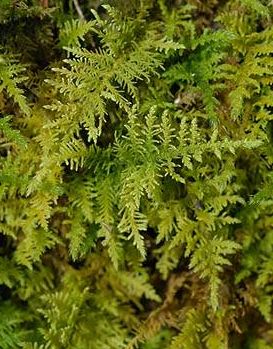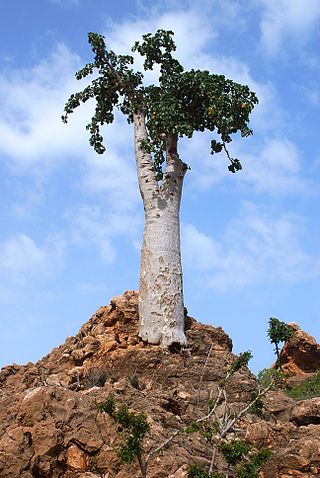
Mosses are small, non-vascular flowerless plants in the taxonomic division Bryophytasensu stricto. Bryophyta may also refer to the parent group bryophytes, which comprise liverworts, mosses, and hornworts. Mosses typically form dense green clumps or mats, often in damp or shady locations. The individual plants are usually composed of simple leaves that are generally only one cell thick, attached to a stem that may be branched or unbranched and has only a limited role in conducting water and nutrients. Although some species have conducting tissues, these are generally poorly developed and structurally different from similar tissue found in vascular plants. Mosses do not have seeds and after fertilisation develop sporophytes with unbranched stalks topped with single capsules containing spores. They are typically 0.2–10 cm (0.1–3.9 in) tall, though some species are much larger. Dawsonia, the tallest moss in the world, can grow to 50 cm (20 in) in height. There are approximately 12,000 species.

Babiana is a genus of geophytes in the family Iridaceae with 93 recognized species as of March 2022. The leaves consist of a stalk and a blade that are at an angle to each other. The leaf blades are entire, laterally flattened and pleated, and often hairy. Each individual flower is subtended by two hairy or smooth bracts that are green in most species. The outer bract is often the largest of the two. In most species the bracts have a dry, brown tip, but in a few species it is entirely green or entirely dry when flowering or the outer bract is translucent and has a papery texture. The inner bract is forked or split all the way to its base. Each flower is without a pedicel, with six tepals that are merged at their base into a tube and form a perianth that is mirror-symmetrical in most species, with three anthers implanted where the perianth tube widens and that are, in almost every species, clustered at one side of the style. The style has three branches that widen towards the tip and the ovary is inferior. Flowers occur in almost every conceivable colour, many have markings on some of the tepals, and few star-symmetrical flowers have a centre that strongly contrasts with the free part of the perianth. The majority of these species are endemic to the west and southwest of South Africa, and southwestern Namibia, but one species occurs elsewhere in Namibia and South Africa and another species can be found in Botswana, Namibia, South Africa, Zambia and Zimbabwe. The genus name is derived from the Dutch word baviaan, referring to the Chacma baboon, Papio ursinus, that consumes the corms of plants in the genus. The genus is called bobbejaantjie in Afrikaans, meaning small baboon.

Ficus lyrata, commonly known as the fiddle-leaf fig, banjo fig, fiddle-leaved fig tree, lyre leaf fig tree, or lyre-leaved fig tree, is a species of plant in the mulberry and fig family Moraceae. It is native to western Africa, but is cultivated around the world as an ornamental plant. It has received the Royal Horticultural Society's Award of Garden Merit.

Nuphar lutea, the yellow water-lily, brandy-bottle, or spadderdock, is an aquatic plant of the family Nymphaeaceae, native to northern temperate and some subtropical regions of Europe, northwest Africa, and western Asia. This species was used as a food source and in medicinal practices from prehistoric times with potential research and medical applications going forward.

Limnophila sessiliflora, known as dwarf ambulia, ambulis, and Asian marshweed is a flowering plant in the family Plantaginaceae.
Neomacounia nitida, or Macoun's shining moss, is an extinct moss that was found only in a small area of Ontario, and the sole species in the genus Neomacounia.

Lobelia scaevolifolia is a species of the plant family Campanulaceae. It is endemic to the island of Saint Helena in the South Atlantic Ocean. It was at one time placed as the only species, Trimeris scaevolifolia, in the genus Trimeris. Its common name is St. Helena lobelia.

Helodium blandowii, also known as Blandow's helodium moss, Blandow's tamarisk-moss, Blandow's bogmoss, and Blandow's feathermoss, is a rare plant in the Western U.S., including Oregon and California. It occurs all around the northern hemisphere in higher latitudes, and in some places is not as rare as in the Western U.S.

Ambuchanania leucobryoides is the only species in the monotypic genus Ambuchanania. It is a Sphagnum-like moss endemic to Tasmania. Originally described as a species of Sphagnum, it is now a separate genus named after the original collector Alex M. Buchanan, (b.1944) an Australian botanist from the Tasmanian Herbarium in Hobart,. A. leucobryoides differs from the family Sphagnaceae in having elongate antheridia. It is entirely restricted to south-west Tasmania's Wilderness World Heritage Area where it occurs on white Precambrian quartzitic sand deposited by alluvial flows, and on margins of buttongrass sedge land. Species most commonly found in association with A. leucobryoides include: Leptocarpus tenax, Chordifex hookeri, and Actinotus suffocatus. Currently, A. leucobryoides is listed as rare under the Tasmanian Threatened Species Protection Act 1995.

The Funariidae are a widespread group of mosses in class Bryopsida. The majority of species belong to the genera Funaria and Physcomitrium.

Hypnales is the botanical name of an order of Bryophyta or leafy mosses. This group is sometimes called feather mosses, referring to their freely branched stems. The order includes more than 40 families and more than 4,000 species, making them the largest order of mosses.

Dendrosicyos is a monotypic genus in the plant family Cucurbitaceae. The only species is Dendrosicyos socotranus, the cucumber tree. The species is endemic to the island of Socotra in Yemen, and is the only species in the Cucurbitaceae to grow in a tree form. The species name was originally spelled D. socotrana, but this is corrected to masculine grammatical gender according to the International Code of Nomenclature for algae, fungi, and plants.
Isoetes eludens is an aquatic plant in the genus commonly known as quillwort that is native to the Kamiesberg Mountains in Namaqualand, South Africa. So far it is known to grow only in a single !gau (gnamma), a small temporary pool formed in a hollowed out area of granite rock. It has likely been growing in that region for millions of years, but was only discovered in 2007 and described in 2009. The specific epithet eludens refers to the fact that it eluded discovery, in spite of several searches in recent years in the area for new quillwort species.
Scadoxus nutans is a herbaceous plant endemic to southwest Ethiopia. Its red to pink flowers face downwards as the top of the flowering stem bends over, unlike any of the other species of Scadoxus. It grows mainly as an epiphyte in tropical mountain forests, which are disappearing, making the species vulnerable to extinction. It is sometimes cultivated as an ornamental plant.

Malaxis seychellarum is a species of orchid endemic to the Seychelles Islands in the Indian Ocean. First described in 1902, it is now considered a vulnerable species.

Warnstorfia exannulata is a leafy branching wetland moss in the genus Warnstorfia within the family Amblystegiaceae and class Bryopsida. This bryopsida moss is also known as ringless-hook moss or Warnstorfia moss. It is the most common species of the genus in wetland environments and can be difficult to distinguish from others within the genus. It grows in acidic soils like fens and bogs, or in freshwater pools and lakes.

Bartramia is a genus of mosses in the family Bartramiaceae. The genus was first formally described by Johann Hedwig in 1801. There are about 72 species, usually growing on soil, sometimes on rocks, in many habitats in many parts of the world, although tropical species are only found at high altitudes. Nine species occur in Australia but only three of these are endemic to that continent.

Glottiphyllum depressum is a common species of succulent plant, of the family Aizoaceae, native to South Africa.

Dracophyllum muscoides, commonly known as cushion inaka, is a small cushion plant in the family Ericaceae. It is endemic to New Zealand and is found only in the South Island in sub-alpine regions.
Rachelia is a monotypic genus of flowering plants belonging to the family Asteraceae. It just contains one species, Rachelia glariaJ.M.Ward & Breitw. It is in the tribe Gnaphalieae.

















